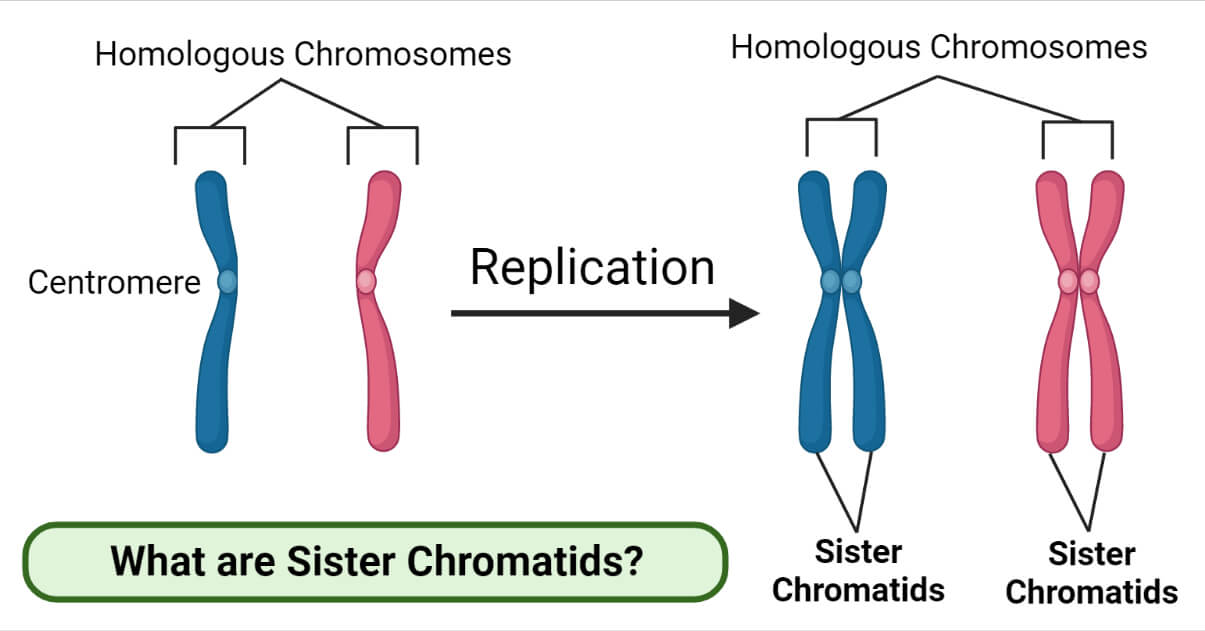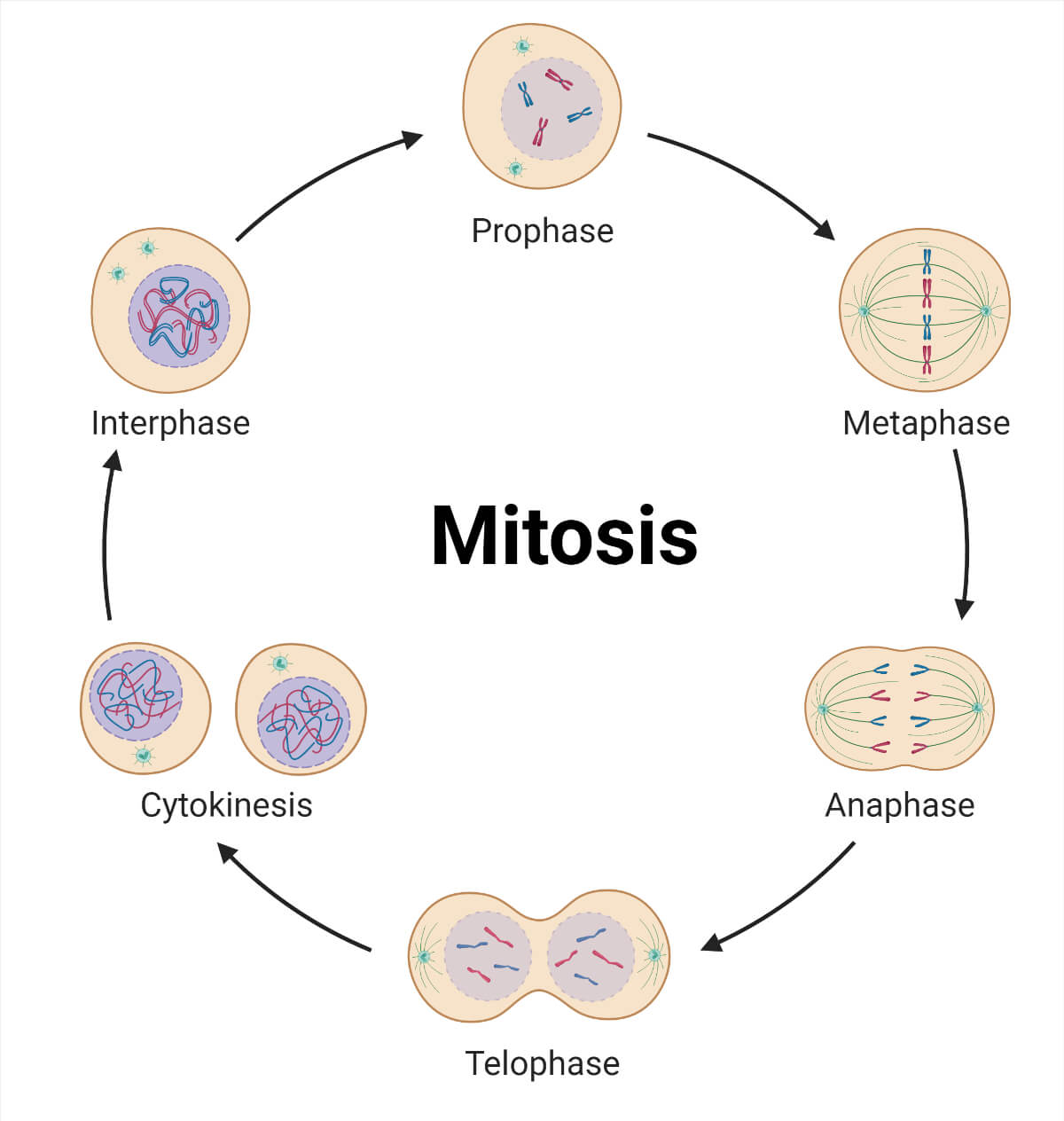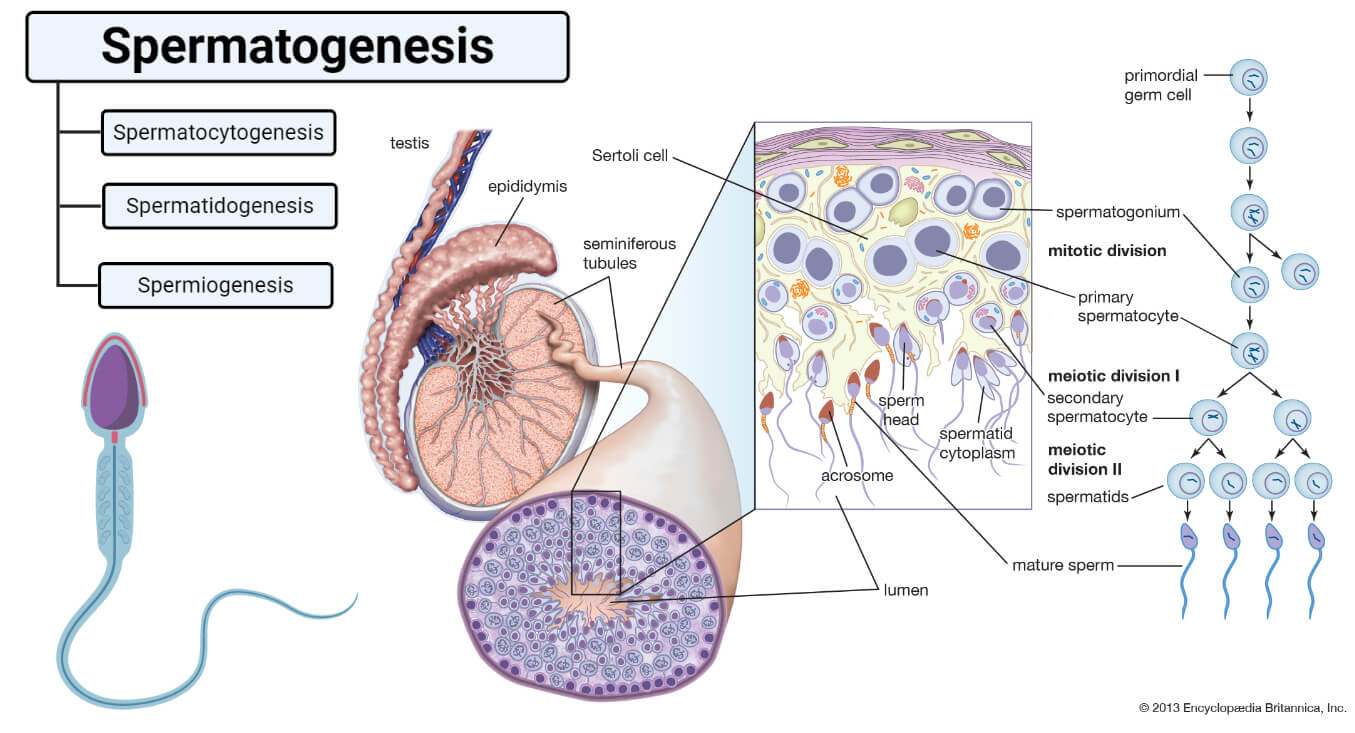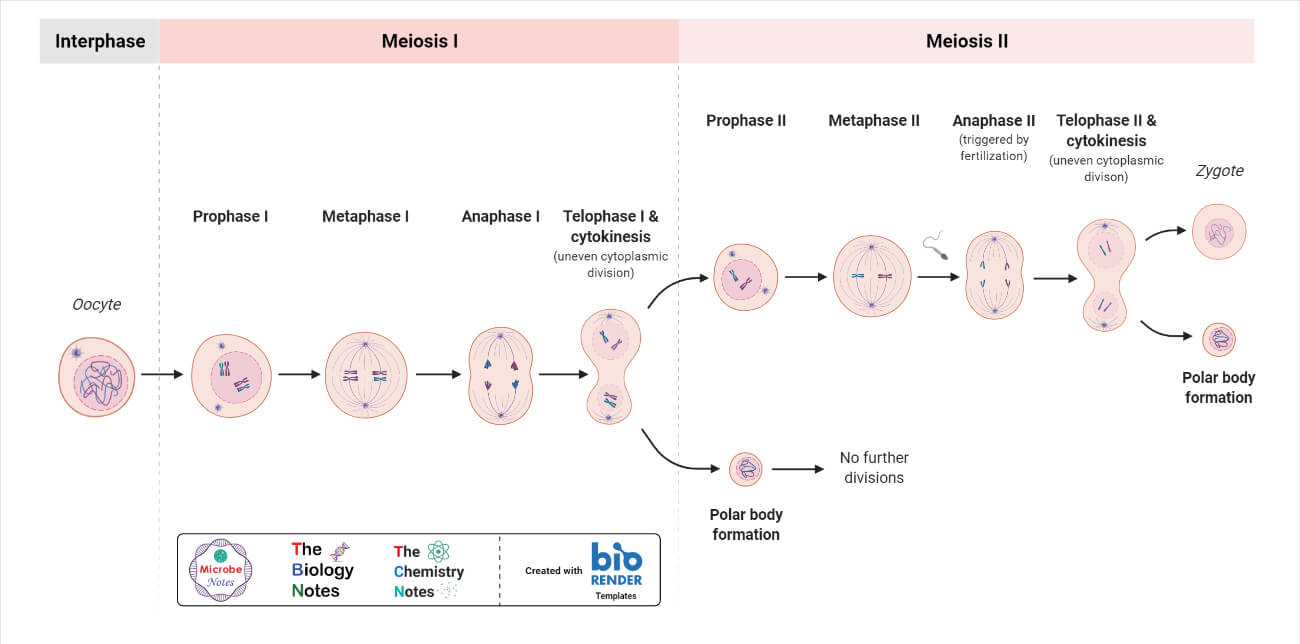Sister chromatids are the two identical copies of the same chromosome attached by the structure called the centromere.
During the interphase (S phase) of cell division, eukaryote chromosomes present in the nucleus are replicated, and two identical copies of each chromosome are formed, which are known as sister chromatids.

- The sister chromatids are connected at the centromere, a constrictive region of the chromosome.
- The sister chromatids are still regarded as one chromosome as long as they are linked at the centromere. However, as soon as they are divided during cell division, each is regarded as a separate chromosome.
- Following the separation of homologous chromosomes in meiosis I, the sister chromatids are separated during meiosis II.
Interesting Science Videos
Sister Chromatids Formation
- The exact duplication of the genome by DNA replication and the ensuing segregation of the two copies of the genome by chromosomal segregation are the two essential processes that make up the chromosome cycle.
- The sister chromatid cohesion is a crucial condition for chromosomal segregation since it is required for the biorientation of chromosomes on the mitotic or meiotic spindle.
- During the subsequent gap (G2) phase and early mitosis, in prophase, prometaphase, and metaphase, the sister chromatid remains united as part of one chromosome. The nuclear envelope disintegrates in the majority of eukaryotes during these stages of mitosis, and chromosomes eventually attach to both poles of the mitotic spindle in all species.
- The sister chromatids are only separated from one another in anaphase when all of the chromosomes have attained biorientation. This allows the mother cell to divide into two genetically identical daughter cells by moving to opposite spindle poles.
- The continuation of physical contact between sister chromatids from the S phase through metaphase is essential for this sequence of events. This physical connection, called sister chromatid cohesion, works to counteract the pulling forces produced by microtubules that attach to kinetochores facilitate the biorientation of chromosomes on the mitotic spindle.
- A multi-subunit protein complex known as cohesin is necessary for sister chromatid cohesion. Smc1, Smc3, and Scc1/Rad21/Mcd1, three of cohesin’s subunits, group together to form a unique ring-shaped structure.
Sister Chromatids Separation
Sister chromatids are joined together over their whole lengths by axis-linking chromatin/structure bridges beginning in the late prophase of mitosis.
These bridges ensure that sister chromatids undergo compaction during prometaphase/metaphase while maintaining a parallel, paranemic relationship and preventing helical coiling.
The removal of bridges is therefore required during anaphase.
Sister chromatid axes separate in three steps. They are:
- Global parallel separation
- Peeling apart
- Final resolution
- Global parallel separation
The sister chromatid axes separate in parallel along their lengths in both arm(s) and centromere/kinetochore regions globally throughout the chromosome complement due to inter-sister chromatin pushing forces one to two minutes before sister chromatid centromeres start to move toward opposite poles visibly.
- Peeling apart
Centromere-proximal bridges are drastically lengthened during this stage by poleward spindle forces, and they are subsequently removed in a topoisomerase IIα-dependent phase.
The separation between centromere regions extends outward along the arms and toward the telomere as they move toward opposite poles.
At the same time, locations far from those that are tearing apart are still parallel but are still experiencing only slight global separation.
- Final resolution
Widely separated chromatids continue to be invisibly linked for few minutes in telomere regions, most likely through catenation, with complete separation occurring during anaphase.
Increased separation of poles and/or chromatin compaction is the driving force of this stage.
Cohesin cleavage enables these events by allowing bridges to respond to imposed forces.
Functions of Sister Chromatid
- The primary function of sister chromatids is to ensure that every daughter cell formed during cell division receives a complete set of chromosomes.
- In cells that have replicated their DNA, the sister chromatid facilitates the repair of DNA double-strand breaks. These breaks can be repaired via a homologous recombination mechanism that employs the undamaged sister chromatid as a template.
- The defects in chromatin structure and gene regulation may result from mutations in the proteins necessary for sister chromatid cohesion.
- Without sister chromatid cohesion, in rare cases, it can result in congenital developmental disorders called Cornelia de Lange syndrome, Roberts/SC Phocomelia syndrome, and Warsaw Breakage syndrome.
- Aneuploidy, which is considered to be the main factor in spontaneous abortion, can result from sister chromatid cohesion defects in human oocytes.
Sister chromatids in mitosis
- In the Prophase of mitosis: movement of the sister chromatids toward the center of the cell.
- In Metaphase: alignment of the sister chromatids along the metaphase plate at right angles to the cell pole.
- In Anaphase: separation of the sister chromatids and movement towards the opposite pole of the cell. After separating the sister chromatids, each chromatid is called a full single-stranded chromosome.
- In telophase and cytokinesis: the sister chromatids that are separated divide into separate daughter cells. The separated chromatids are known as daughter chromosomes.

Sister chromatids in meiosis
Meiosis is similar to that mitosis and is a two-part cell division process.
- In Prophase I and Metaphase I: movement of the sister chromatids in both the phages.
- In Anaphase: homologous chromosomes move to the opposite pole, and sister chromatids remain attached.
- The separation of the sister chromatids does not occur until anaphase II.
- Four daughter cells are produced during the meiosis cell division; each cell receives one-half the number of chromosomes as the original cell.
- Sex cells are also produced by meiosis.


Non-sister Chromatid
Any one of the two chromatids of paired homologous chromosomes can be referred as a non-sister chromatid.
The non-sister chromatids of homologous chromosomes produce chiasmata to exchange genetic material during prophase I of meiosis I and are genetically non-identical.
Sister Chromatid vs. Non-sister Chromatid
| Basis | Sister chromatid | Non-sister chromatid |
| Definition | The centromere connects the two chromatids of a replicated chromosome. | The two chromatids are from two different homologous chromosomes. |
| Genes | They are genetically identical since they are produced by DNA replication. | Genetically non-identical since each non-sister chromatid is inherited from each parent. |
| Alleles | Contain the same alleles at the same loci. | Contain different alleles of the same genes at the same loci. |
| Formation | Formed during the S phase of the interphase. | Formed during the metaphase I of meiosis. |
| Location | They are found on the same chromosome. | Found in a homologous chromosome pair. |
| Involvement | Involved in asexual reproduction. | Involved in sexual reproduction. |
References
- Biology Dictionary. (2017). Sister Chromatid. Accessed from: https://biologydictionary.net/sister-chromatids/
- Biology Online. (2022). Non-sister chromatid. Accessed from: https://www.biologyonline.com/dictionary/non-sister-chromatid
- BioNinja. (2022). Sister chromatid. Accessed from: https://ib.bioninja.com.au/standard-level/topic-3-genetics/33-meiosis/sister-chromatids.html
- Chu, L., Zhang, Z., Mukhina, M., Zickler, D., & Kleckner, N. (2022). Sister chromatids separate during anaphase in a three-stage program as directed by Interaxis Bridges. Proceedings of the National Academy of Sciences, 119(10). https://doi.org/10.1073/pnas.2123363119
- Khan Academy. (2022). Chromosome. Accessed from: https://www.khanacademy.org/science/ap-biology/cell-communication-and-cell-cycle/cell-cycle/a/dna-and-chromosomes-article
- Lakna. (2017). Difference Between Sister and Nonsister Chromatids. Accessed from: https://pediaa.com/difference-between-sister-and-nonsister-chromatids/
- National Human Genome Research Institute (NIH). (2022). Chromatid. Accessed from: https://www.genome.gov/genetics-glossary/Chromatid
- Peters, J. M., & Nishiyama, T. (2012). Sister chromatid cohesion. Cold Spring Harbor perspectives in biology, 4(11), a011130. https://doi.org/10.1101/cshperspect.a011130
